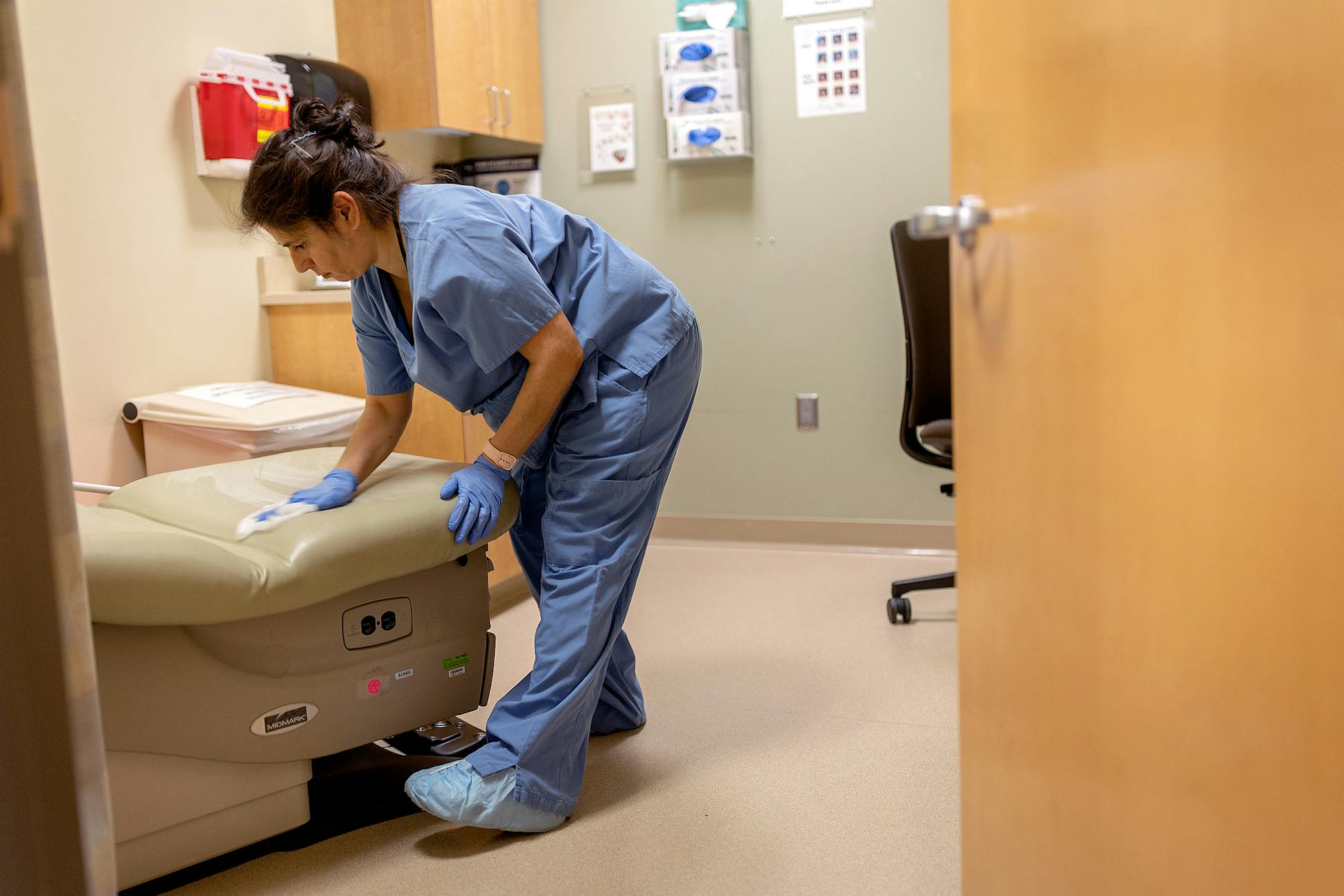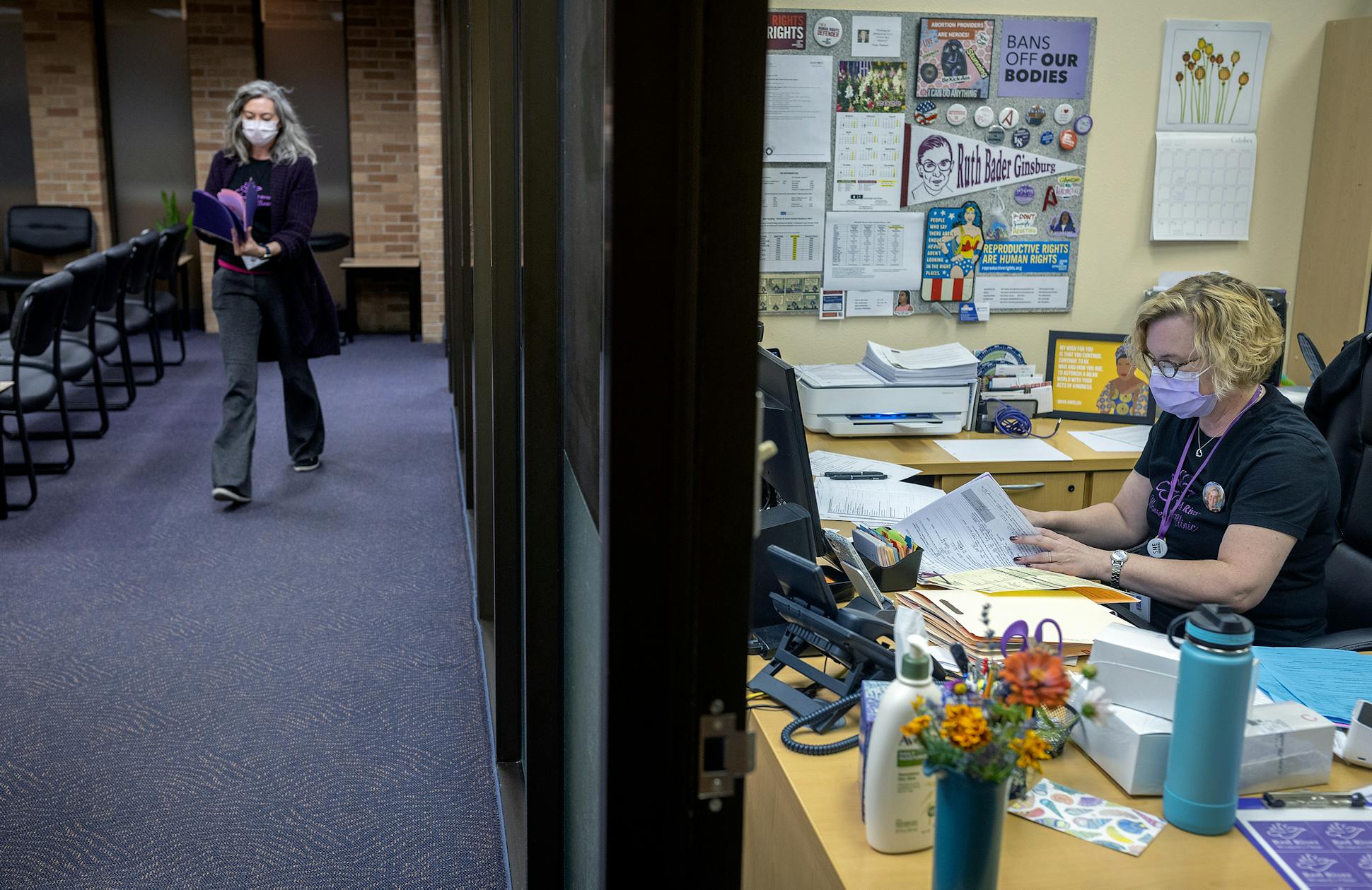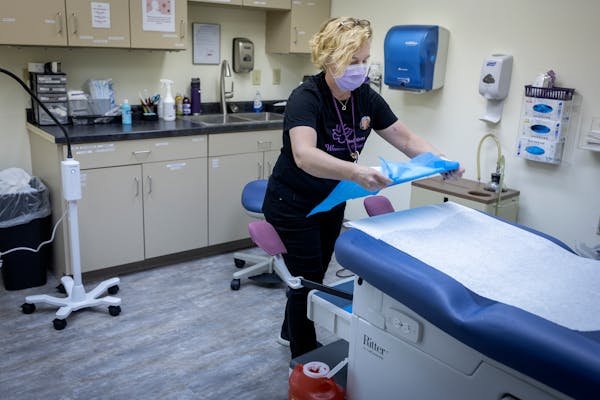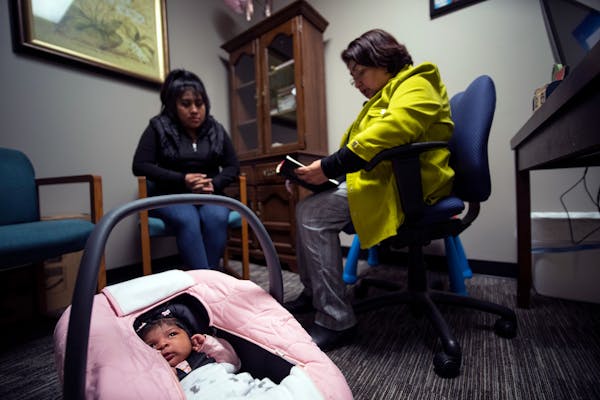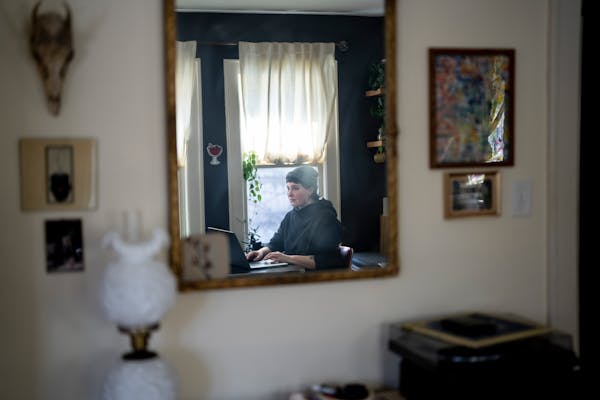n a recent weekday at Planned Parenthood's clinic in St. Paul, Dr. Sarah Traxler had already seen two people for abortion appointments from South Dakota, two from Wisconsin and one woman who flew in from Texas — all before noon.
"We're seeing people from places we've never seen before — Alabama, Texas and Louisiana," said Traxler as she dunked crackers into a small tub of cheese, all she had time to eat during a hurried lunch break. Another person she saw that morning drove 15 hours to get to her Minnesota appointment.
For those traveling such distances, "it's so fraught with emotion," added Traxler, a physician and chief medical officer for Planned Parenthood North Central States. "They are responding a lot more to the stigma attached to the fact that they want this so badly that they will drive 15 hours to get here."
Planned Parenthood always served patients from outside Minnesota, but the numbers have doubled in the last year since the U.S. Supreme Court overturned Roe v. Wade. The ruling on June 24, 2022, instantly removed five decades of constitutional protections for abortion, triggered abortion bans in some states and set off a flurry of legislative activity to restrict access in others, including all the states bordering Minnesota.
Minnesota moved swiftly in the opposite direction, codifying abortion rights and protections into law while knocking down waiting periods, an informed consent requirement and other restrictions that had been in place for decades.
Abortion opponents have raised the alarm about the removal of many regulations.
"We have gotten rid of all of the laws that protected women," said Cathy Blaeser, co-executive director of Minnesota Citizens Concerned for Life, which opposes abortion. "Whether she is a Minnesotan, Iowan or South Dakotan, the tragedy of abortion and the harmful effects of abortion on all women are a concern to us."
For Minnesota abortion providers, the changes have solidified Minnesota's status as a regional island of access. It's helped them meet the increased demand, post-Roe.
"It's been a long time since we've seen this much support. We feel really motivated, like we're being set up for success," said Paulina Briggs, executive director of the WE Health Clinic in Duluth, the only abortion provider for more than 100 miles in any direction.
"It's such a conflicting year to look back on," she added. "There are victories, but it's so heartbreaking to think about people outside of Minnesota."
Confronting the challenges
Before the Supreme Court ruling, both North and South Dakota had one abortion provider. Wisconsin was home to a handful of facilities that provided abortions. Not long after the ruling, they were all gone.
That's created a bottleneck as many of those patients stream into Minnesota for a limited number of abortion appointments, increasing wait times. Planned Parenthood saw a 25% increase overall in abortion appointments in Minnesota last year, and an 11% increase in second-trimester abortions since Roe fell, increasing the pressure to make sure there are no disruptions in the schedule.
While much of the state was closed down last winter during a multi-day snow storm, a skeleton crew of staff at the Vandalia Street clinic in St. Paul came in to see several patients who would have had few options if their appointment had been canceled.
"Our staff are really feeling the urgency to get people in, so they're jumping through hoops to see as many patients as they can," Traxler said.
There's also been a nearly 20% jump at Planned Parenthood in people traveling for appointments who are choosing surgical abortions. Medication abortions can take more than one day, which is challenging for people coming from out of state.
Providers struggle with combating confusion among patients about where abortion access is restricted or protected, said Ruth Richardson, CEO of Planned Parenthood North Central States. As a result, more patients are traveling to Minnesota without family or any support out of fear of getting into trouble.
"We rely on our loved ones when we need health care," said Richardson. "We're trying to help demystify and confront the challenges of this manufactured confusion, so people know when and how they can access services."
The influx of travelers heading to metro-area providers has led some Minnesota patients to travel to places such as Chicago. Briggs said the Duluth clinic saw a 25% increase in patients in 2022, largely people from the Twin Cities area.
"It was this ripple effect that we didn't anticipate," Briggs said.
Minnesota also sends physicians to other states where there's a surge in demand. After Roe was overturned, Traxler started flying to Nebraska for several days each month to provide abortions in Omaha and Lincoln.
Last month, lawmakers there passed an abortion ban after 12 weeks of pregnancy, which will limit what can be done there. Abortion is still legal in Iowa up to 20 weeks, but Traxler is worried legislators there will try to pass new restrictions after the state's Supreme Court recently blocked a six-week ban.
"It's still those shifting sands," she said. "When all those things happen, we're going to see a shift to even more people coming to Minnesota."
Opportunity to expand
Minnesota has long been considered a regional haven for abortion rights, with a state Supreme Court decision protecting access for nearly three decades. The reversal of Roe only supercharged the state's status.
Last July, a Ramsey County judge struck down a handful of abortion restrictions that had been in place for decades, including a 24-hour waiting period, a parental notification for minors and an informed consent requirement. Democrats took full control of the Legislature in the fall elections, advancing an ambitious agenda last session that removed most of the restrictions from law, much to the disappointment of abortion foes.
MORE FROM THIS SERIES
"Progressives in Minnesota are trying to turn the clock back and strip protections from women and preborn children in Minnesota," said Minnesota Family Council CEO John Helmberger. "In the long run, their efforts will fail."
Abortion providers say lifting those restrictions has helped the state meet the moment. Eliminating a requirement that only physicians could administer medication abortions has allowed clinics to increase their staffing.
Planned Parenthood trained 15 new advanced practitioners in the last year who can handle medication abortions. Dr. Julie Amaon, who runs Just the Pill, a non-profit telemedicine abortion provider based in the Twin Cities, has increased staffing from 10 people to 30 following the ruling, including more clinicians like herself. Amaon and her staff saw quadruple the usual number of appointment requests the day after Roe was overturned, and demand is still up overall.
"It's really now about the long game," Amaon said. "This didn't happen overnight. We knew it was being slowly chipped away."
Whole Woman's Health, which operates six clinics in five states, including Minnesota, moved a physician to its Bloomington location from Texas, where providers can face criminal penalties for providing abortions. Minnesota lawmakers boosted protections for providers and patients traveling for abortions.
"There's this fear that Texas will go after him because of the work he did here," said Amy Hagstrom Miller, founder and CEO of Whole Woman's Health. "Protections like the safe harbor law are really critical for physicians who hold licenses in more than one state."
Things have arguably changed the most over the last year for Tammi Kromenaker, who helped close the deal on a new 12,000-square-foot location for the Red River Women's Clinic one day before the ruling came down.
Forty-seven days later, they'd officially moved from Fargo, N.D., to Moorhead, Minn., or as she puts it: "Five minutes away to be in a whole new world."
Since the ruling, they've seen a 10% to 15% increase in appointments overall and people traveling from as far away as Texas. Kromenaker, the clinic's director, was initially worried about the cost of the new location, triple the size of their old facility.
But now they're installing plumbing and putting the finishing touches on two more exam rooms, doubling the number they had in their old space.
"We may add a day or two to meet the demand, now that we have the space for that," said Kromenaker. A fresh coat of paint was drying in the rooms as she spoke.
